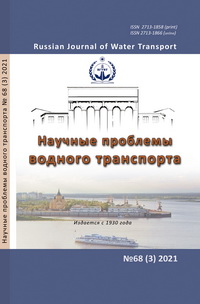Analysis of monetary income of the population: time challenge
Abstract
The article presents a theoretical and practical view of the income category; the concept of a household is considered. The analysis of the composition and structure of the monetary income of Russians in the whole country in the period from 2015 to 2019 is carried out and the regional aspect is presented: Nizhny Novgorod region population’s monetary income for this period is analyzed. On the basis of a comparative analysis of all-Russian trends in the composition and structure of population’s monetary income and the situation in the region, the current state of monetary income certain types individuals and the economic behavior of Russians is characterized. The author uses the methodology of the statistical survey of the population of Rosstat in the analysis of each Russians monetary income component; points out its disadvantages. The analysis of the composition and various components structure of Russians monetary income allows us to place emphasis on the sources of population’s monetary income in a market economy. The author highlights the income from entrepreneurial activity and emphasizes their importance in the market economy; considers the entrepreneurial activity of Russians in dynamics. The article provides a detailed analysis of the income from property indicator of the population of the country and in the Nizhny Novgorod region and justifies the most significant source of additional funds for the population at present. A critical assessment of the revealed dynamics of each population's monetary income component and the possibility of strengthening state structures control over the income and expenses of individuals is given.
References
Тучина Ю.В. Сущность доходов населения // Инновации и инвестиции. 2018. № 12. С.61-64.
Сабетова Т.В. Новый подход к классификации источников доходов населения // Эко-номика труда. 2018. Том 5. № 2. С. 587-598. DOI: https://doi.org/10.18334/et.5.2.39011
Бондаренко Н.А. Исследование доходов населения Хабаровского края // Ученые замет-ки ТОГУ. 2018. Том 9, № 1. С. 625-631.
Гэлбрейт Дж. Экономические теории и цели общества. М.: Прогресс, 1979. 406с.
Булавинец В. М., Захарек А.Н. Теоретические основы доходов домохозяйств // Акту-альные научные исследования в современном мире. 2019. № 10-4(54). С. 29-33.
Костюк И.В. Занятость и самозанятость как формы доходной деятельности граждан // Российский журнал правовых исследований. 2017. Том 4. №2. C. 202-206. DOI: https://doi.org/10.17816/RJLS18339
Хикс Дж. Р. Стоимость и капитал: Пер. с англ. М.: Прогресс, 1993. 448с.
Guide to non-profit organizations in the SNA. Department of economic and social affairs.
Statistics division. Methodical studies series F, № 91. Guide to national accounts. New York and Geneva: United Nations. 2006. 395 p. URL:https://unstats.un.org/unsd/publication/SeriesF/SeriesF_91r.pdf
Economic Commission for Europe. Conference of European Statisticians. Group of Experts on National Accounts. Tenth session Geneva, 26–29 April 2010 Item 1 of the provisional agenda Towards implementation strategy for the 2008 SNA in the EECCA and SEE countries. Imple-mentation of the 2008 System of National Accounts in the Eastern Europe, Caucasus and Central Asia, South East Europe and Mongolia. 2010. 19p. URL:https://unece.org/fileadmin/DAM/stats/documents/ece/ces/ge.20/2010/30.e.pdf
Официальный сайт Федеральной службы государственной статистики. Методологи-ческие положения по расчету показателей денежных доходов и расходов населения. URL: https://rosstat.gov.ru/ (дата обращения 13.04.2021).
Маркова Н.А., Любимова Е.А. Использование финансов для решения социальных проблем // Вестник Волжской государственной академии водного транспорта. 2016. № 46. С. 122-131.
Верховская О. Р., Богатырева К. А., Дорохина М. В., Кнатько Д. М., Шмелева Э. В. Национальный отчет. Глобальный мониторинг предпринимательства. Россия 2019/2020 СПб.: ВШМ СПбГУ, 2020. URL: https://gsom.spbu.ru/images/cms/menu/otchet_2020-red-2n-04-06.pdf (дата обращения 21.04.2021).
Янцен А.В. Альтернативные оценки доходов населения в регионах России // Про-странственная экономика. 2017. № 1. С. 52-70. DOI: https://doi.org/10.14530/se.2017.1.052-070
Мигранова Л. А. Денежные доходы населения России в 2013-2018 гг.: результаты из-менений в методологии Росстата // Уровень жизни населения регионов России. 2020. Том 16. № 2. С. 25-35. DOI: https://doi.org/10.19181/lsprr/2020.16.2.2.
Официальный сайт Федеральной службы государственной статистики. Официальная статистика/Население /Уровень жизни. URL: https://rosstat.gov.ru/folder/13397
Официальный сайт Федеральной службы государственной статистики по Нижегород-ской области. Официальная статистика / Население / Уровень жизни. URL: https://nizhstat.gks.ru/folder/32657
Маркова Н. А., Полазнова М.А. Актуальные проблемы социального страхования в России // Вестник Волжской государственной академии водного транспорта. 2014. № 40. С. 211-214.
Россия в цифрах. 2020: Краткий стат. сборник. М.: Росстат, 2020. 550с. URL: https://rosstat.gov.ru/storage/mediabank/GOyirKPV/Rus_2020.pdf
Маркова Н. А. Усиление роли домохозяйств как конечных потребителей валового внутреннего продукта и изменение системы групп финансовых отношений // Вестник Волжской государственной академии водного транспорта. 2017. № 53. С. 134-140.
Гаджиев Ю. А. Финансы домашних хозяйств: региональный анализ располагаемых ресурсов // Север и рынок: формирование экономического порядка. 2019. № 2(64). С. 105-115. DOI: https://doi.org/10.25702/KSC.2220-802X.2.2019.64.105-115
Воронин Г. Л., Захаров В.Я., Козырева П.М. Измерение устойчивости домохозяйств: 1994 2017 гг. // Социологический журнал. 2020. Том 26. № 1. С. 55-86. DOI: https://doi.org/10.19181/socjour.2020.26.1.7053.
Copyright (c) 2021 Russian Journal of Water Transport

This work is licensed under a Creative Commons Attribution 4.0 International License.













